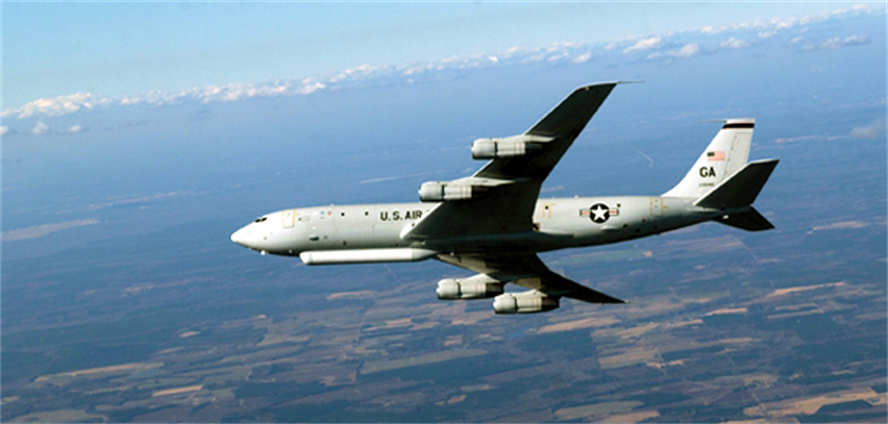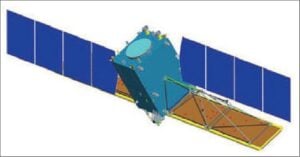
JSTARS
WASHINGTON: Space Force chief Gen. Jay Raymond today revealed a previously classified program to develop radar satellites capable of tracking moving ground targets — a harbinger of the service’s nascent plan to take on the job of procuring space-based ISR for the other services.
Raymond told the annual McAleese conference that Space Force is “building GMTI [Ground Moving Target Indicator] from space” as part of its ISR push, saying that program is representative of the fact that the service is “actively working to be able to provide that capability.”
Public disclosure of the program’s existence “is a recent example of the concerted effort to declassify information regarding space capabilities in support of greater transparency in the space domain,” Col. Catie Hague, Space Force spokesperson, told us in an email.
That said, not many details have been disclosed — including the name of the project or its budget.
The space-based GMTI program isn’t yet an “operational capability,” Hague explained. It is a risk-reduction effort started in 2018 by the Air Force Rapid Capabilities Office (RCO) to help fill the gap left by the planned retirement of the Joint Surveillance Target Attack Radar System (JSTARS).
“The space-based GMTI system will replace a portion of the JSTARS sensing capability” and “will support all combatant commands,” she explained. “Space-based GMTI will provide another way to harness data from the space domain and incorporate it into the secure cloud environment underpinning the Advanced Battle Management System to sense, make sense, and act faster than our adversaries.”
ABMS, of course, started out focused on replacing JSTARS, but soon expanded to encompass developing tech (largely based on modern software) to support a military Internet of Things as a foundation for DoD’s Joint All Domain Command and Control (JADC2) plan.
“The space-based GMTI system will surpass the range limitations of current air platforms and will provide capabilities in contested and non-contested environments,” Hague added.

China’s Gaofen3 experimental satellite, China Association for Science and Technology (CAST) image
Put simply, a GMTI radar using a pulsing technique to discriminate moving targets, such as enemy tanks and mobile missile launchers, from stationary objects and clock their velocities based on their Doppler shift. In recent years, satellite operators have been combining GMTI radar and synthetic aperture radar (SAR) to create even more precise tracks — for example, China with its Gaofen-3 experimental satellite.
The effort, and the ISR push writ large, also sets Space Force up for a potential turf battle with the NRO, which currently builds, buys and operates intelligence, surveillance and reconnaissance spy sats, and buys ISR data from commercial satellite providers. Further, it raises questions about the Army’s plans to pursue its own ISR payloads.
Raymond, however, maintained that Space Force is not jumping NRO’s patch. Instead, it is working to set a dividing line between responsibilities for strategic and tactical space-based ISR.
“Historically, the ISR business has not been something that Air Force Space Command, or the Space Force now, has done; that’s largely been an Intelligence Community effort,” he said. “I really believe as satellites and technology is getting smaller, smaller satellites are becoming more operationally relevant, and as launch cost goes down, there’s a role here for the Space Force at the tactical level. And so we’re working with the Intelligence Community to do this, and do it in a way that is complimentary.
“I really believe this is an area that we’ll begin to migrate to, because we can do it, and we can do it in a way that doesn’t break the bank, and is focused on our joint coalition partners.”
(Indeed, several US allies already operate SAR satellites for military and/or commercial uses, including Canada, with RADARSAT which also has a GMTI capability on-board; Germany, with SAR-Lupe; and France, with Helios.)
Raymond also downplayed any potential conflict with the Army’s Tactical Satellite Layer program, stressing that, at the moment, Space Force isn’t yet doing the tactical ISR mission itself.
Indeed, there hasn’t yet been a formal decision within DoD who should have that responsibility, Derek Tournear told the McAleese conference. “Right now, there is not a defined plan on who in the department would build out those satellites. There’s not even a defined plan on what that overall constellation would look like. There’s a lot of debates on on that internal,” he said.
(And although it has its eye on the mission, nor is Space Force yet providing ISR data gleaned from commercial operators; that remains in the hands of NRO and the National Geospatial-Intelligence Agency. Lt. Gen. JT Thompson, head of Space and Missile Systems Center, told the Mitchell Institute today that the idea of creating a Commercial Space Solutions Office to provide ISR and other space services is a “mid-term vision” for the future Space Systems Command.)
“As we grow our ISR capability, I’m hoping that they — and all the other services — will look to us, and we’ll be able to do it more effectively and be valued,” Raymond said. “But if not, then the Army needs to continue doing what they do. And so we’ll see how that matures as time goes on. … We’ve got to mature that, and once that’s mature, I think then we can make those future decisions.”






















